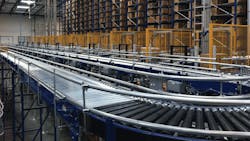The shipping dock is to warehousing what the pace car is to a car race. No matter how efficiently all the disparate processes in the modern warehouse or distribution center (DC) may be capable of running, none of them — full case picking, broken case picking, slow mover area, non-conveyables, etc. — can operate any more efficiently than the shipping dock can handle them. The reason, of course, is the need to keep the dock area free of clutter so product can be organized for staging and shipped out when the truck arrives. As a result, if a truck is scheduled to reach the dock at 2:00 p.m., the order is picked so that it's timed to arrive at the dock shortly before that time.
While that works on the shipping end, it can actually limit the productivity of workers, not to mention the technology for which the enterprise may have paid hundreds of thousands or millions of dollars. It makes more sense to pick four orders at once than one at a time. Doing so cuts out all the travel time (multiplied by every item in every order), saves wear and tear on the forklift or person, and frees that worker to perform other tasks.
AS/RS as Accelerator
An automatic storage and retrieval system (AS/RS) can act as a buffer that allows enterprises to decouple all the various processes in order to maximize the efficiency of each. Rather than cruising at the speed the shipping dock can handle, the enterprise can run each process closer to the redline while being assured that product will still arrive for staging and shipping when needed — with a greater degree of flexibility to account for the variables in actual shipping versus schedules. Here's how using AS/RS as a buffer works. Each area picks product at its optimum pace, then delivers it to the AS/RS buffer area to be stored temporarily on a shelf or floor. A forklift driver or walking worker can pull all four orders from an area simultaneously, place the product on the conveyor, and the conveyor takes it to the AS/RS area while noting the location of each order. Other portions of the order are picked and stored similarly at whatever time is optimal for that process — without regard for what is happening in the other processes. When the truck arrives at the guard station and is assigned a dock, the AS/RS begins pulling the order and putting it on the conveyor so it can be loaded. While one portion of the order is being put on the truck, another may still be retrieved by the system. The entire process brings a "just in time" feel to the last mile in the warehouse.
Overcoming Speed Bumps
Just because a truck is scheduled to arrive at 2:00 p.m. on Tuesday doesn't mean it will. In fact, you might not be willing to bet on that. A traffic tie-up, blown tire or mechanical problem with the truck can delay it well past the scheduled time. If an order is sitting on the floor waiting to be loaded at 2:00 and the truck doesn't arrive until 6:00, that's four hours that order is cluttering up the floor and tying up dock space. This can be inconvenient in a large warehouse with many docks, and it is downright frustrating in a small facility with just a few docks and limited floor space. With an AS/RS being used as buffer these issues are eliminated because the order doesn't need to be assembled until the truck actually arrives. In the meantime, the scheduled dock is free to take on other trucks. And if, by some miracle, the truck arrives early the enterprise can also take advantage of that fact and move swiftly, avoiding an expensive truck and driver sitting idle until the order has been completely pulled and staged.
Jim Neuner is vice president of system sales for Wynright Corporation (www.wynright.com), an independent U.S.-based provider of intelligent material handling systems.
